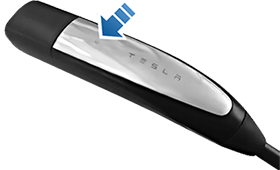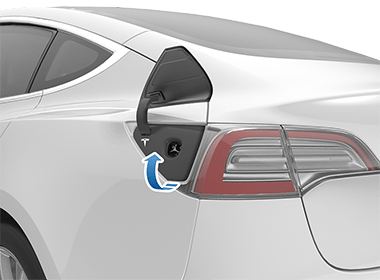Not sure about choosing a charger? Try our revamped Charger Finder!
Try our revamped Charger Finder!
- For Installations
- All our chargers come with a 1 year warranty
- Free Shipping
November 1, 2023
We own and have used many Teslas, as we have spoken to owners of vehicles with Tesla. Below is a charging guide and tip sheet for charging a Tesla.

If needed, you can adjust the charge limit and the charging current using the touchscreen (see Charge Settings). Some customers like to adjust the charging limit so that charging stops during peak times to save on electricity costs or to match the current rate to that of the battery acceptance rate.
To charge at a public charging station, simply plug the appropriate adapter into your vehicle’s charging port and connect the station’s charging connector to the adapter. The commonly used adapter(s) for your market region are typically provided. Depending on the charging equipment in use, you may need to initiate and terminate charging using controls on the charging equipment itself.
Like with all EV chargers, remember to plug it into the power outlet before connecting it to your Model 3. If you must unplug the EV charger, we always recommend switching the plug off at the breaker first by locating the circuit on the breaker, providing power to the EV plug.
All Tesla EV chargers have a NACS connector (North American Charging Standard) and are either 40 amp level 2 residential or 48 amp hardwired residential EV chargers.
Follow these steps to ensure a successful connection:

Safety Alert: Be cautious when handling the charge cable connector end. Always look at the cable for damage or exposed wire. Always check the integrity of the Tesla EV charger NACS connector end where the charging head meets the cable. This is a common failure point.
The color of the charge port light conveys essential information:
When the charge port door is open, charging status information is displayed at the top of the car status screen:
While charging, the charge port light (the Tesla “T” logo) pulses green, and the touchscreen provides real-time charging information. As your charge level approaches full, the frequency of the green charge port light pulsing slows down. Once charging is complete, the light will stop pulsing and remain solid green.
Please note: If your Model 3 is locked, the charge port light will not illuminate. In the event that the charge port light turns red while charging, this indicates a fault has been detected. Review the touchscreen for an alert explaining the issue. Common causes for faults include power outages, among others. If a power outage occurs, charging will resume automatically once power is restored.
You can cease charging at any moment by either disconnecting the charging cable physically or selecting “Stop Charging” on the touchscreen.
Please note:
To detach the charge cable, follow these steps:
In cases where you’re using an adapter at a public charge station, the process differs slightly:
Important Safety Reminder: Tesla recommends your Tesla remain plugged in when not in use. This helps maintain the Battery at an optimum level of charge.
To access charge settings, follow these steps:
Within these settings, you’ll find options for:
Tesla has an extensive SuperCharger Network fitted with Tesla-specific adapters, aka NACS connectors. When charging at a Tesla supercharger, data about the charging session is displayed at the bottom of the charging screen. This data includes the location, the time the charging session began, and an estimated cost for the session. Even after you stop supercharging, the estimated cost remains on the screen until a new supercharging session starts.
Please note: The estimated cost may not reflect the final cost of the supercharging session. You can find the final pricing for supercharging sessions in your Tesla account.
At Tesla superchargers, idle fees are in place to encourage drivers to move their vehicles from the Supercharger once the charging is complete. These fees only apply when more than half of the Superchargers at a site are occupied. The Tesla mobile app will notify you when charging is almost finished and again when it is complete. Additional notifications are sent if idle fees are incurred. It’s important to note that idle fees are waived if you move your vehicle within five minutes of the completion of the charging session.
To review fees and access information about Supercharger sessions, payment setup, and payments, log into your Tesla account. Once a payment method is saved, fees are automatically settled through your account.
To ensure the best performance of your Tesla and Battery life, consider the following best practices:
If the usual methods for releasing the charging cable from the charge port (using the charge handle release button, touchscreen, or mobile app) do not work, follow these steps:
These instructions should allow you to manually release the charging cable when other methods are not effective.
TOTALEV, AEFA, and EV-Chargers are trademarks of EV Warehouse Inc (Party). The Party, its marketing, and manufacturing are not associated with automotive car manufacturers (Parties) referenced above.
EV Warehouse Inc. acknowledges the sole ownership by the other Parties and validity of all trademarks, trade dress, logos, and slogans owned by the other Parties, as well as used or intended to be used in connection with the EV chargers of Party, as applicable.
The Party does not assert or claim any interest in or do anything that may adversely affect the validity or enforceability of any copyright, trademark, trade dress, logo, or slogan owned by the other Parties. The sole reason for the use of the other Parties marks is to describe the compatibility, fit and intended use with cars of Parties for the purpose of appropriate owner selection of charger type, charging speeds and most cost-effective EV charger.
© 2025 EV Chargers. All rights reserved. Developed by Infinite Group.